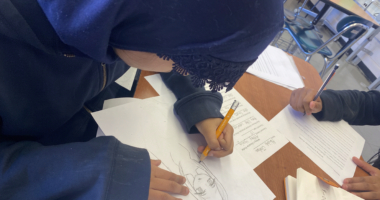“I have a voice
My voice is powerful
My voice can change the world…”
On the first day of Community-Word Project’s Teaching Artist Training & Internship Program (TATIP), I was really inspired by this mantra above that Program Director Patti Chilsen shared. We call this out sometimes at the end of the class as a closing ritual.
Teaching for social justice is about igniting in others that they have a powerful voice that matters and that can create change. This is what my mission is as an artist for social change. This is what my mission is as a teaching artist. This is why I joined TATIP. Because if we can instill hope, empowerment, and support individuality and inclusiveness in the youth, we are layering wavelengths of hope in their beings so that they don’t grow up hardened. They can instead grow up able to contribute and ameliorate a situation, rather than run away and feel powerless. We know that what happens in our youth is crucial to our human development. So when we allow a loving, open, expressive, and empowering environment for youth, we are preparing them to be better citizens and co-creators of a new reality.

During the first seminar, one of the themes we explored was, “how to create a safe space.” We started off doing an exercise called “Graffiti Walls.” There were different large pieces of paper on the wall; each with a different question on them for us to anonymously respond to on the paper. This is useful for people who aren’t as vocal, and is a good icebreaker when in a new group environment, so that people can read the responses and see the similarities and differences without needing to know who said it. We also did an exercise called, “Mingle Mingle.” We walked around the room and had to stop in front of a partner, sharing answers to various questions that were on a piece of paper, such as, “what inspires you to be an artist.”

One of the highlights of the seminar was a “Nature Walk.” Patti led us in a walk around the room where we all had to embody nature. We made sounds by tapping on our bodies and using our feet or voices. Another highlight was when each of the facilitators shared a piece of their own art. We were reminded that, “teaching art starts with you.” We did free-writing and had to create a piece of art or monologue, poem, or song, telling our story as an artist, to a partner. We were also reminded that, “to educate, doesn’t mean to ‘put in,’ but to “pull out.” This has to do with allowing students to discover and come up with answers themselves, rather than the teacher “telling them” what something is.

We learned various elements of teaching. One element was “scaffolding.” Scaffolding means layering a lesson, so that there is an introduction and exercises leading up to a main activity, so that the main activity is easier to digest. Another aspect of teaching we learned to apply was the art of “rituals.” A ritual is an activity we do in the beginning of a class to warm up our bodies and minds and get us centered, preparing us for the lesson.
I feel gratitude for being a part of this organization and growing my skill set, so that I can be a greater asset for youth and the world.
-Kate Hess, Writer & Media Artist, TATIP Trainee



